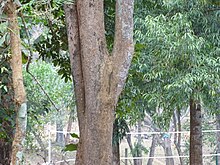Lophira alata
| Lophira alata | |
|---|---|

| |
| Scientific classification | |
| Kingdom: | Plantae |
| Clade: | Tracheophytes |
| Clade: | Angiosperms |
| Clade: | Eudicots |
| Clade: | Rosids |
| Order: | Malpighiales |
| Family: | Ochnaceae |
| Genus: | Lophira |
| Species: | L. alata
|
| Binomial name | |
| Lophira alata | |
Lophira alata, commonly known as azobé, ekki or the red ironwood tree, is a species of
The timber is extremely hard and used for railroad ties, groynes and bridge planking.
Description
The trunk of Lophira alata is usually straight, without
Biology
Lophira alata sheds all its leaves during a short period of one to two weeks, usually in December, and the re-growth of bright red young leaves, often simultaneously on all L. alata trees in an area, can set the canopy ablaze with colour. The flowers of L. alata are white, fairly large, strong-smelling, and grouped in loose, branched, terminal inflorescences. Flowering occurs in adult trees with trunks over 50 centimetres in diameter, and takes place from the time the new leaves appear. L. alata is
Uses

The timber, known as azobe, is strong and resistant making it useful for demanding constructions outdoors. The timber also has better electrical properties than other wood making it possible to use it in poles for
Sniffing the bark is used as a traditional treatment for
References
This article incorporates text from the
- ^ a b African Regional Workshop (Conservation & Sustainable Management of Trees, Zimbabwe) 1998. Lophira alata. 2006 IUCN Red List of Threatened Species. Downloaded on 22 August 2007.
- ^ a b Azobé Retrieved 2011-08-24
- ^ J Nat Prod. 2006 Aug;69(8):1206-8. Tih AE, Ghogomu RT, Sondengam BL, Caux C, Bodo B. University of Yaounde I, P.O. Box 812, Yaounde, Cameroon.
- ^ Biosci Biotechnol Biochem. 1992 May;56(5):769-72. Chalcone tetramers, lophirachalcone and alatachalcone, from Lophira alata as possible anti-tumor promoters. Murakami A, Tanaka S, Ohigashi H, Hirota M, Irie R, Takeda N, Tatematsu A, Koshimizu K. Department of Food Science and Technology, Faculty of Agriculture, Kyoto University, Japan.
External links
![]() Media related to Lophira alata at Wikimedia Commons
Media related to Lophira alata at Wikimedia Commons
- azobe/lophira-alata Lophira alata media from ARKive

